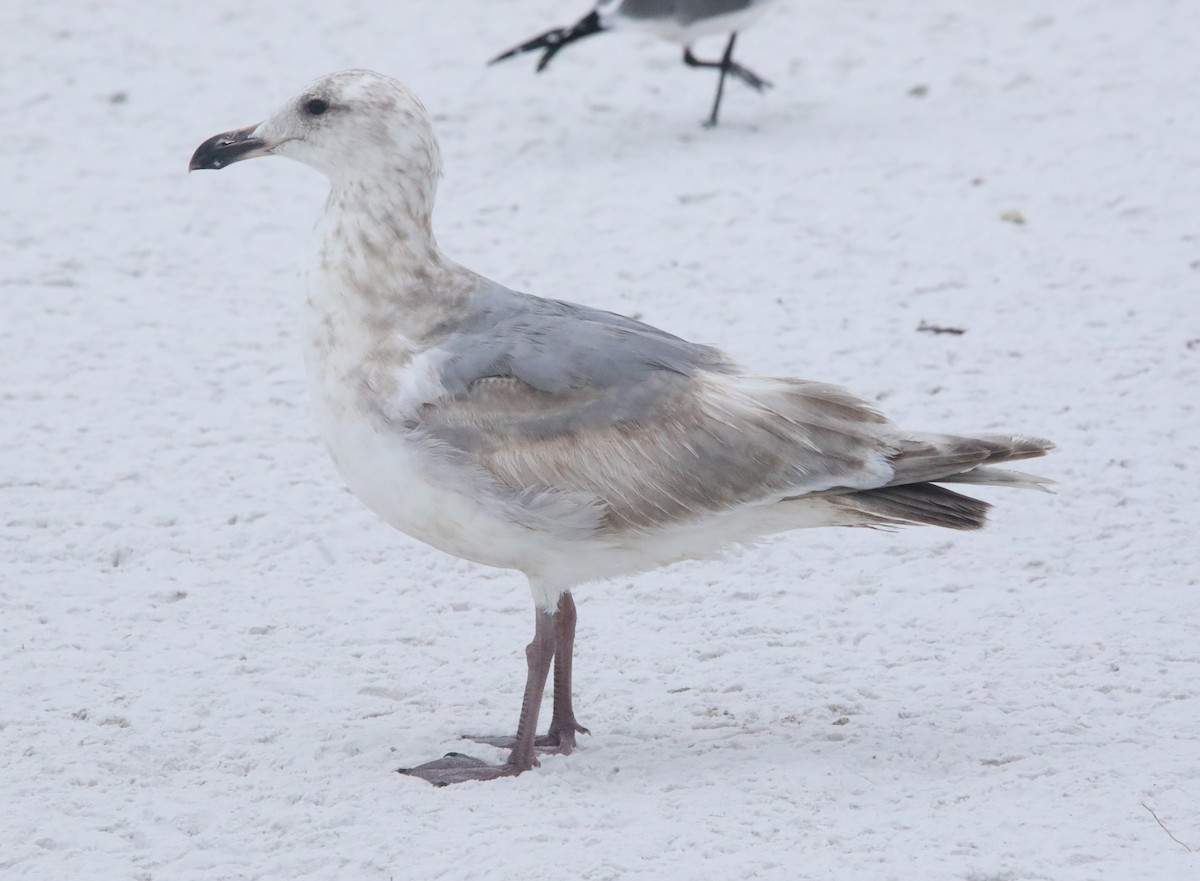
ML630976647
Contributor
Date
Location
- Age
- Not specified
- Sex
- Not specified
Observation details
Whoa, mama - MEGA*** 1st-state record if acceptably decided as pure, though anything with GWGU is a first for Florida, I believe. Will submit to FOSRC. 2nd or 3rd-cycle bird - the exceptional wear for a bird this age was what initially caught my eye. Stocky and front-heavy, with short primary projection. Soft head and neck markings with dark eyes and bill are all unusual for Herring in general or for current age. Dark-shinned and dirty-legged appearance seems to be a GWGU trait. Primaries and tail too pale for Herring. Large larus, averaged as large/slightly larger than nearby associating American Herring. Aged 2nd cycle or delayed 3rd-cycle bird, with light blue-gray 3rd-generation mantle feathering and potentially a mix of 2nd and 3rd-generation secondaries. Some 3rd-generation lesser coverts, but mostly 2nd-generation wing panel, albeit worn. Primaries appear overall pale, but worn, 2nd (?) generation feathering. Tail is 2nd-generation (?) with some remnant patterning remaining. Structurally, a robust and front-heavy nature, with short primary projection immediately questions Herring in build. Large head with long bill and engorged tip appropriately Glaucous-winged. For the age, the dark iris and mostly dark bill would be unusual for American Herring. The legs and feet were a muddy or "dirty" pink-purple, with this quality and dark shins being common in that species vs typicalities for Herring. The main areas of contention will be the nature of the wings and tail - currently, mixed opinions based on location coupled with conservative outlook, but overall, opinions leaned "mostly" GWGU-heritage, or broadly "good" for a pure bird. Personal comparions with online media and field guides lead me to believe this bird would fall into the category of "acceptably pure" if I were to review this as another birder's submission. That stated, first-hand experience with this species and hybrid-types is lacking. Dependant on light, tail appeared minorly-to-moderately gray/gray-brown. Inner webs of rectrices appear lighter and uniformly gray than outer webs, perhaps due to the overlapping of feathers? The central rectrices were generally the darkest portions. The tails of hybird Glaucuous-winged Gull x American Herring seem to typically present more obviously Herring-end, appearing dark brown/cold brown throughout. Outer flight feathers were overall pale with darkened tips from P8-P4, most notably to P4/6-8. The outer webs of P10-6 were varying degrees of darker gray-brown, but generally this tone was restricted to the tips. P8 bilaterally showed the most distintive darkened tips. Pseudo mirrors are somewhat visible on P10, with hints of the "string of pearls" effect visible on the open-wing. As previosuly stated, the darkened feathering seems mostly restricted to the tips, with extensive dark feathering asbsent from the extent of each feather as it approaches the primary coverts. P10 exhibits a dark outer web for most of its length, though this doesn't appear to be an issue. Within available media, similar wing qualities are found rather frequently among the various ages of this species, including 2nd and 3rd-cycle birds. Comparing to American Herring x Glaucous-winged, it does generally appear that these birds have extensive darkness to the entire outer shafts of the outer primaries or extensive dark tips to the majority of the flight feathers, not shown in this bird. Typically seen in these birds is a majority of the flight feathers will appear darker and extensively so, however, more GW-end birds are present with these traits as well. Western x Glaucous-winged doesn't appear to be an issue, with strucutre and plumage not matching well for this combo to be in play. Comparions with local and recently-viewed worn and "bleached" birds has not provided birds with a similar presentation to this bird. The primaries of these birds while perhaps lightened, do not show a stark contrast of pale and dark areas as this bird shows, suggesting the extent of the darkness in the feathering may not be necessarily limited to where it is now due to wear. https://ebird.org/checklist/S214591608 --- mostly clear skies with direct afternoon lighting.
Technical information
- Model
- Canon EOS 5D Mark IV
- ISO
- 12800
- Flash
- Flash did not fire
- Dimensions
- 5434 pixels x 3989 pixels
- Original file size
- 1.88 MB

